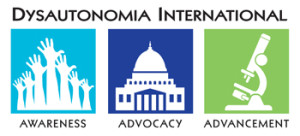
ST. GEORGE — When Alyna Eaves fell ill with a sinus infection in November 2014, she had no idea how much her life was about to change. She would eventually be diagnosed with a syndrome known as POTS: postural orthostatic tachycardia syndrome.

Alyna Eaves was an athletic, energetic girl who loved dancing, but after the illness struck, her life changed dramatically. Gone was the energy, gone was the ability to function normally on a day-to-day basis. She remained ill, despite the multiple courses of antibiotics and repeated visits to the hospital. It would take months for a diagnosis to come.
Postural orthostatic tachycardia syndrome falls under the umbrella of what is known as dysautonomia, a group of conditions which affect the autonomic nervous system, meaning that it affects unconscious functions such as breathing, heart rate, temperature control and blood pressure. Those who suffer from the syndrome experience lightheadedness, exhaustion, heart palpitations and an inability to exercise.
Tara Eaves, Alyna’s mother, said it was likely the sinus infection caused her daughter to develop postural orthostatic tachycardia syndrome.
“That’s one thing with POTS, is there’s many different things that can set off your autonomic system. One of them is an illness,” Tara Eaves said. “For her it was an illness, for other people it can be a concussion, it can be a car accident, it’s anything traumatic to the body that the autonomic system decides that it wants to go on the fritz.”

Brittany Hollinshead, the reigning Mrs. Ivins 2016, also suffers from the condition and has used her platform to spread awareness of the disease to a larger audience. In October 2015, Hollinshead and Alyna Eaves met with St. George Mayor Jon Pike and the St. George City Council, who agreed to declare October as “Dystautonomia Awareness Month.”
“It’s not a rare condition, it’s just rarely diagnosed and that’s the problem,” Hollinshead said. She has lived with the syndrome for 11 years but did not receive a diagnosis for the first seven years.
“Constant emergency room visits, going to every specialist known to man. Seven years is far too long to be wondering am I just suffering from anxiety or post-partum depression, which is what they kept telling me.”
During a two-month period from when Alyna Eaves fell ill until December 2014, Tara Eaves estimates they spent six weeks in the hospital. She said:
Dizziness was one of her first big symptoms that we weren’t able to explain, then she started having issues where she couldn’t breathe properly, couldn’t catch her breath – her chest was hurting. We spent six weeks hospitalized, but it would come in five-day increments, so we’d be hospitalized for five days, we’d get out for two days and she’d decline, and we’d be hospitalized again.
Alyna Eaves said she feels frustrated and angry to have been forced to give up activities she once loved like singing and dancing.
“You get really angry because you can’t do anything anymore, you pretty much give up your social life … what you used to love is now a thing of your past, you can’t hang out with friends because you have to cancel because you don’t feel good and you’re dizzy and you just can’t do anything, you don’t have any energy left.”

Her illness has also disrupted her education.
“I miss about three-quarters of the school year because I can’t get out of bed and off the couch,” she said.
With the assistance of administrators at Tuacahn High School, Alyna Eaves does much of her education online, although she does attend classes as often as possible.
The illness has turned the Eaves family upside-down, Tara Eaves said. A credentialed teacher, she has had to give up her full-time position and work instead as a para-professional, which allows her a degree of flexibility she did not have as a teacher.
“That way I don’t have to come to work early, I don’t have to stay late for meetings,” Tara Eaves said. “If she needs me, I can leave; that way, I don’t have a classroom I don’t (sic) need to find coverage for.”
Like many of those dealing with this syndrome, Alyna Eaves spends an inordinate amount of time at doctors’ offices and at the hospital.
“We were just there last week, a couple of ER visits,” Tara Eaves said. “Doctor’s appointments, ER visits — you try not to go to the ER unless it’s really important because they don’t really understand POTS, so there’s nothing they can really do.”
Both Tara Eaves and Hollinshead said their main hope is to raise awareness about the syndrome.
“This is an invisible illness, you can’t see it,” Tara Eaves said. “Every test that came back during our diagnosis was ‘she’s perfectly fine, this is normal, that is normal, we don’t know what’s wrong with your daughter’. It is easily diagnosed if doctors were aware of it.”
The test for postural orthostatic tachycardia syndrome involves taking blood pressure readings over a period of time, with the patient moving from a lying-down position to standing, Tara Eaves said. A tilt-table test is also an option, but is much more expensive, she said.
Since her diagnosis, simple changes in diet have made a dramatic difference in her ability to function, Hollinshead said. By eliminating all grains, adopting a paleo diet and increasing her sodium intake, she was able to quickly recover.
“That was a huge turning point,” Hollinshead said. “I would say within three weeks of changing the way I ate, all of a sudden I could stand up, I could think clearer and I wasn’t having these moments where I felt like I was going to faint every time I stood up.”
So far, even with dietary and lifestyle changes, Alysa Eaves has not been able to recover her former energy, but there is a possibility the disease could go into remission, she said, something she is hopeful will come to pass.
“Only for a percentage does it eventually go away,” Alysa Eaves said. “So I’m hoping I can get rid of POTS, but it’s a slim chance.”
Resources
- Dysautonomia Internation Web page
- Dysautonomia/POTS in Southern Utah Facebook page
- Utah POTS Facebook page
Email: [email protected]
Twitter: @STGnews
Copyright St. George News, SaintGeorgeUtah.com LLC, 2016, all rights reserved.